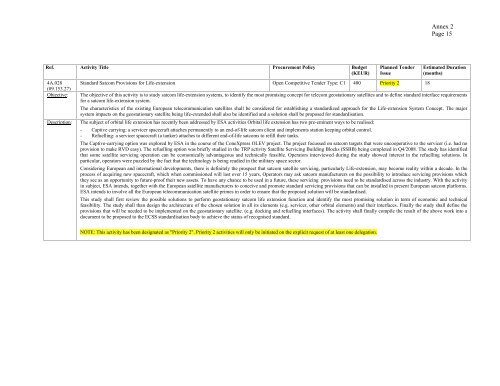ARTES-5.1 â ESA Telecom Technology Workplan ... - Emits - ESA
ARTES-5.1 â ESA Telecom Technology Workplan ... - Emits - ESA
ARTES-5.1 â ESA Telecom Technology Workplan ... - Emits - ESA
- No tags were found...
Create successful ePaper yourself
Turn your PDF publications into a flip-book with our unique Google optimized e-Paper software.
Annex 2Page 15Ref. Activity Title Procurement Policy Budget(KEUR)4A.028(09.153.27)Objective:Description:Planned TenderIssueStandard Satcom Provisions for Life-extension Open Competitive Tender Type: C1 400 Priority 2 18Estimated Duration(months)The objective of this activity is to study satcom life-extension systems, to identify the most promising concept for telecom geostationary satellites and to define standard interface requirementsfor a satcom life-extension system.The characteristics of the existing European telecommunication satellites shall be considered for establishing a standardized approach for the Life-extension System Concept. The majorsystem impacts on the geostationary satellite being life-extended shall also be identified and a solution shall be proposed for standardisation.The subject of orbital life extension has recently been addressed by <strong>ESA</strong> activities Orbital life extension has two pre-eminent ways to be realised:- Captive carrying: a servicer spacecraft attaches permanently to an end-of-life satcom client and implements station keeping orbital control.- Refuelling: a servicer spacecraft (a tanker) attaches to different end-of-life satcoms to refill their tanks.The Captive-carrying option was explored by <strong>ESA</strong> in the course of the ConeXpress OLEV project. The project focussed on satcom targets that were uncooperative to the servicer (i.e. had noprovision to make RVD easy). The refuelling option was briefly studied in the TRP activity Satellite Servicing Building Blocks (SSBB) being completed in Q4/2008. The study has identifiedthat some satellite servicing operation can be economically advantageous and technically feasible. Operators interviewed during the study showed interest in the refuelling solutions. Inparticular, operators were puzzled by the fact that the technology is being readied in the military space sector.Considering European and international developments, there is definitely the prospect that satcom satellite servicing, particularly Life-extension, may become reality within a decade. In theprocess of acquiring new spacecraft, which when commissioned will last over 15 years, Operators may ask satcom manufacturers on the possibility to introduce servicing provisions whichthey see as an opportunity to future-proof their new assets. To have any chance to be used in a future, these servicing provisions need to be standardised across the industry. With the activityin subject, <strong>ESA</strong> intends, together with the European satellite manufacturers to conceive and promote standard servicing provisions that can be installed in present European satcom platforms.<strong>ESA</strong> intends to involve all the European telecommunication satellite primes in order to ensure that the proposed solution will be standardised.This study shall first review the possible solutions to perform geostationary satcom life extension function and identify the most promising solution in term of economic and technicalfeasibility. The study shall than design the architecture of the chosen solution in all its elements (e.g. servicer, other orbital elements) and their interfaces. Finally the study shall define theprovisions that will be needed to be implemented on the geostationary satellite. (e.g. docking and refuelling interfaces). The activity shall finally compile the result of the above work into adocument to be proposed to the ECSS standardisation body to achieve the status of recognised standard.NOTE: This activity has been designated as "Priority 2". Priority 2 activities will only be initiated on the explicit request of at least one delegation.
















